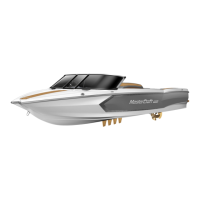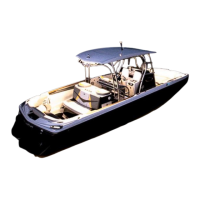ANNUAL MAINTENANCE
19-7
Check the ballast pump impeller
This applies only to boats equipped with some type of ballast system. The
number of ballast pumps varies from system to system. You may need guid-
ance from your dealer to locate any and all pumps.
Step 1: Remove two of the cover screws and retain the screws for
the reinstallation process. Swing the cover out of the way to allow
access to the impeller location.
Step 2: Using the needle-nose pliers, pull the old impeller out of
the casing.
Step 3: Install the new impeller. (It is intentionally larger than the case.
While gently squeezing it in, ensure that the paddle wheels angle in the same
direction--counterclockwise--all the way around.)
Step 4: Slide the plate back into place. No silicone is necessary. Due
to the built-in gasket, tightening the screws should prevent leakage.
Inspect complete fuel system for leakage
Although your boat engine is similar to your automobile engine, the engine compartment differs substantially. The
underside of your automobile engine compartment is totally open to the atmosphere. This allows complete air circulation and
ventilation. Your boat engine is housed in a closed compartment, the underside of which is the bottom of the boat.
The enclosed engine compartment limits the ventilation of gasoline and oil fumes. Because confined gasoline vapors
mixed with a little air can form an explosive atmosphere, it is important to be especially vigilant in performing the following
two operations:
Step 1: Run your bilge blower for at least four minutes to ventilate the bilge area each time before starting
the engine.
Step 2: Inspect your boat
bilge area under the engine for
the evidence of oil and
gasoline–or any gasoline odor.
This inspection should take
place the first time the boat is
started each day. Raise the
engine cover and visually look
at the bilge area under the
engine.

